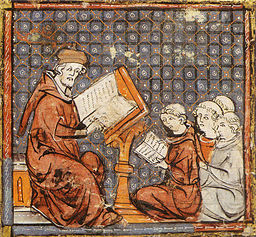By Dr. Niall Christie, Department of History, Latin and Political Science
 A technique that I like to use from time to time in my history classes is to have the
A technique that I like to use from time to time in my history classes is to have the
students to take on the roles of medieval figures, in order to encourage them to see the primary sources that they are reading “from the inside,” as it were. This helps them to get a better understanding of how the medieval writers saw the world.
One case where this seems to have particularly engaged the students is in a class that I run as part of my HIST 1123 (Late Medieval World) course.
In the class in question, we examine the establishment of the first universities in Europe, at Bologna, Paris, Oxford and Cambridge. Having primed the students with a lecture, and had them read some primary documents from the time, I then divide them into “committees” charged with establishing a university in 12th-century Europe. I require each committee to think about one of the following:
- Where is the university to be established? What resources can we take advantage of?
- How is the university to be financed? Some universities relied mainly on fees paid directly to the masters by their students. Others received endowments from kings, nobles and clergy that helped to support them.
- How are the students and masters to be organised? Some universities were under the control of their masters, while others were controlled by the students, who hired the masters to teach them. In the meantime, students were often organised into “nations,” groupings based (sometimes *very* vaguely) on place of origin, which helped them to maintain solidarity in times of trouble.
- What are we going to teach? The first subjects studied at universities were the Seven Liberal Arts (grammar, logic/dialectic, rhetoric, astronomy, arithmetic, geometry and music). After that various courses of advanced study were available (especially law, medicine, and theology – the “queen” of the sciences), but different universities were best known for particular subjects. Bologna, for example, was the primary centre for study of law at the time.
- Finally, what rules should we impose on masters and students? At times students and masters could be seriously rowdy; one German master killed several colleagues, and was only dismissed when he stabbed one at a faculty meeting. Oxford had to forbid the bringing of bows and arrows to class! Universities sought as far as possible to gain charters enabling them to regulate their own populations, independent of local authority, so regulations were a serious concern.
After group discussion, the committees report back to the class, and we create our ideal medieval university together on the board.
I have found that the opportunity to design an educational institution, similar to the one in which they are studying but with many differences as well, seems to be something that the students enjoy, and in the process they become more keenly aware of how different the education system is in the modern day, even while it still has deep roots in the past. This helps to bring the middle ages alive and demonstrate its modern relevance.

